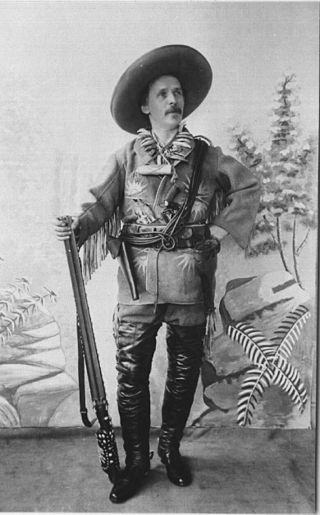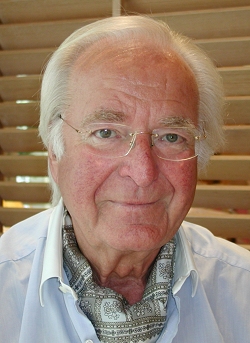
Karl Friedrich May was a German author. He is best known for his novels of travels and adventures, set in the American Old West, the Orient, the Middle East, Latin America, China and Germany. He also wrote poetry, a play, and composed music. He was a proficient player of several musical instruments. Many of his works were adapted for film, theatre, audio dramas and comics. Later in his career, May turned to philosophical and spiritual genres. He is one of the best-selling German writers of all time, with about 200,000,000 copies sold worldwide.

Alexander Crichlow Barker Jr., known as Lex Barker, was an American actor. He was known for playing Tarzan for RKO Pictures between 1949 and 1953, and portraying leading characters from Karl May's novels, notably as Old Shatterhand in a film series by the West German studio Constantin Film. At the height of his fame, he was one of the most popular actors in German-speaking cinema, and received Bambi Award and Bravo Otto nominations for the honor.

Winnetou is a fictional Native American hero of several novels written in German by Karl May (1842–1912), one of the best-selling German writers of all time with about 200 million copies worldwide, including the Winnetou trilogy. The character made his debut in the novel Old Firehand (1875).

Old Shatterhand is a fictional character in Western novels by German writer Karl May (1842–1912). He is the German friend and blood brother of Winnetou, the fictional chief of the Mescalero tribe of the Apache. He is the main character in the Eurowestern by the same name from 1964, starring Lex Barker, as well as in six more films of the Winnetou film series.

Martin Böttcher was a German composer, arranger and conductor.

Pierre-Louis Le Bris, known as Pierre Brice, was a French actor, best known as portraying fictional Apache-chief Winnetou in German films based on Karl May novels.
Karl May film adaptations are films based on stories and characters by German author Karl May (1842–1912). The characters Old Shatterhand, Winnetou, and Kara Ben Nemsi are very famous in Central Europe.

Götz George was a German actor, the son of actor couple Berta Drews and Heinrich George. His arguably best-known role is that of Duisburg detective Horst Schimanski in the TV crime series Tatort.

The film Old Shatterhand is a successful Eurowestern based on the character Old Shatterhand, written by German novelist Karl May and part of the Winnetou series. It is a West German CCC Film production co-produced with French, Italian, and Yugoslav companies and filmed in 70mm. Financed with roughly DM 5,000,000, the film was the most expensive Karl May western. Composer Riz Ortolani used a chorus for his film score.

Der Schuh des Manitu is a 2001 German Western parody film. Directed by Michael Herbig, it is a film adaptation of the Winnetou sketches from his ProSieben television show Bullyparade. With earnings of about 65 million Euro and 11.7 million visitors in cinemas, it is one of the most successful German movies after the Second World War.

Gojko Mitić is a German-Serbian actor and director. He gained great popularity in the German Democratic Republic (GDR) as the leading actor in historical and fictional Indian personalities in numerous DEFA Indian films. His popularity may be recognizable from the fact that both in the GDR and later in the Federal Republic of Germany attempts were made to attach labels to him: "DEFA bosses" on the one hand, "Winnetou of the East" on the other. However, Gojko Mitić never portrayed the latter role in a film. This Winnetou formulation refers more to the popularity of Gojko Mitić compared to the actor of the role from the West, the Frenchman Pierre Brice.

Last of the Renegades is a 1964 German-Italian Western film directed by Harald Reinl and starring Pierre Brice, Lex Barker, and Anthony Steel. It is based on a Karl May novel, and was part of a series of adaptations produced by Rialto Film. The film is a sequel to Apache Gold.

The Desperado Trail is a 1965 West German film directed by Harald Reinl.
' WinneToons ' is a 26-part German cartoon series that is loosely based on characters from the novel Winnetou 1st part by Karl May. The first episode ran on March 30, 2002, on ARD. Then the episodes were repeated on the KiKA. The pilot was released on DVD by Universal. In 2009 there was a cinema adaptation with the title WinneToons - The legend of the treasure in Silbersee.

Apache Gold, also known as Winnetou the Warrior, is a 1963 Western film directed by Harald Reinl. It is based on the story of Winnetou, a fictional Native-American Apache hero from the Winnetou series of German novels. It was a major commercial success, selling about 77 million tickets at the worldwide box office.
Gert Günther Hoffmann was a German actor and director. He achieved fame in German film and television as a voice actor in dubbing.
The Trace Leads to the Silver Lake is a 1990 East German animated puppetoon Western film directed by Günter Rätz. It tells the story of how Old Shatterhand, with the help of Winnetou, races against bandits in search of a treasure. The film is based on the novel The Treasure of Silver Lake by Karl May. It was released on 19 January 1990. It won the 1991 Goldener Spatz for best animated film.

Winnetou and the Crossbreed is a 1966 West German Western film directed by Harald Philipp and starring Lex Barker, Pierre Brice, Götz George and Uschi Glas. It is part of the series of Karl May adaptations produced by Rialto Film during the decade. It was co-produced with Italy and Yugoslavia. The budget was an estimated three and a half million Deutschmarks.

The Valley of Death or Winnetou and Shatterhand in the Valley of Death is a 1968 western film directed by Harald Reinl and starring Lex Barker, Pierre Brice and Rik Battaglia. It was the last in a series of films based on Karl May novels. These had previously enjoyed major commercial success, although this film's box office returns were disappointing. It was effectively a remake of an earlier film in the series Treasure of the Silver Lake.















